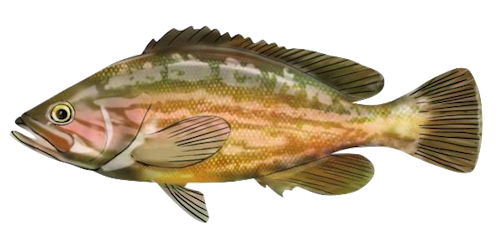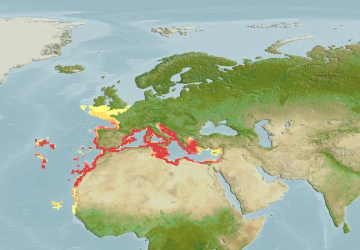Mycteroperca Rubra
– Mottled Grouper –

| Conservation status |
|---|
 Least Concern (IUCN 3.1)[1] |
| Scientific classification |
Mycteroperca rubra (Bloch, 1793)
| Kingdom: | Animalia |
| Phylum: | Chordata |
| Class: | Actinopterygii |
| Order: | Perciformes |
| Family: | Serranidae |
| Subfamily: | Epinephelinae |
| Genus: | Mycteroperca |
| Species: | M. rubra |


The mottled grouper (Mycteroperca rubra) is a species of marine ray-finned fish, a grouper from the subfamily Epinephelinae which is part of the family Serranidae, which also includes the anthias and sea basses. It is found in the eastern Atlantic Ocean and the Mediterranean Sea.
Description
The mottled grouper has an oblong, compressed body which has a depth which is less than the length of its head, its standard length is 2.8 to 3.2 times its depth. The preopercle has a serrated margin with the serrations being enlarged at its angle, where there is a rounded lobe below an incision into the margin.[3] The dorsal fin contains 11 spines and 15-17 soft rays while the anal fin contains 3 spines and 11-12 soft rays.[2] The caudal fin is truncate in juveniles and subadults but it is concave in adults with a standard length of more than 50 centimetres (20 in).[3] They are usually reddish brown in colour, often mottled with black or pale grey spots and having a black streak above the upper jaw. The juveniles have a black saddle blotch on the caudal peduncle. This species has a maximum published total length of 144 centimetres (57 in), although a more common total length is 80 centimetres (31 in), while the maximum published weight is 49.7 kilograms (110 lb).[2]
The size of the king grouper can reach 80 cm, but its average length is around 50 cm.
Its general shape is elongated but squat, compressed laterally. The body is covered with rough scales, even on the base of the fins.
Its livery is brown or dark red, more or less marbled with lighter tones . The tones lighten on the sides which can be marked with irregular, dark lines .
The dorsal fin is in two parts: thorny rays at the front, soft rays at the back. These are taller than the thorny rays . The anal fin is dense: 11 or 12 soft rays, and long. These last two characteristics are an exception in groupers, which makes it possible to distinguish the king grouper. The caudal fin ends practically straight.
The silhouette, finally, is marked by a very prominent lower jaw. The head is pointed. The eye is small and the operculum has three spines. In the mouth, the teeth line up in two rows.
Juveniles, up to a size of 25 cm, have a different livery, with dark diagonal bars on the operculum and a black dot on the caudal peduncle *.
Distribution
The mottle grouper is found in the eastern Atlantic Ocean and parts of the Mediterraean Sea. In the eastern Atlantic, it is found from southern Portugal and Spain, along the western coast of Africa as far south as Angola. It was formerly found in the southern Mediterranean from southern Spain and Morocco to Egypt and Israel but it has been expanding its range and is now found as far north as Provence in France and the Adriatic Sea. It is absent from the Black Sea and records from the Macaronesian Islands are misidentifications of Island grouper (Mycteroperca fusca) and records from Brazil are similarly misidentifications of the comb grouper M. acutirostris.[1]
Biotope
The king grouper is a sedentary and solitary species, living near the coast, at depths varying between 15 and 100 m, although it is more frequent to meet it in the 50 m zone.
It likes rocky bottoms or the edge of underwater meadows. It can also be satisfied with sandy bottoms.
Habitat and Biology
The mottled grouper is a demersal species which occurs over rocky reefs and adjacent sandy substrates as deep as 200 metres (660 ft). It tens to be commoner at shallower depths from 1 to 30 metres (3.3 to 98.4 ft) in the eastern Mediterranean. It readily takes to artificial reefs such as shipwrecks off Sicily. Juveniles are usually found in shallower inshore waters. It feeds on molluscs and small fishes. It is a protogynous hermaphrodite, the transition from female to male happens when they are nine years oold and have attained a total length of 53 centimetres (21 in). The females reach sexual maturity at a total length of about 27 to 32 centimetres (11 to 13 in) around four and five years of age. Spawning aggregations have been recorded off Israel, Senegal, Turkey and Corsica.[1]
Alimentation
It is a powerful and voracious predator that hunts on the lookout in its own territory. It mainly feeds on small fish, but also on cephalopods.
Reproduction
The king grouper matures around 4-5 years, which is approximately 40 cm in length.
He is a protogynous hermaphrodite * (first female) and changes sex during his life, around 9 years old and more than 50 cm in length.
In the Mediterranean, spawning takes place in late spring.
Similar Species
The Black Grouper ( Epinephelus costae ) is fairly pale brown-beige in color, with 4-5 dark lines more or less visible in the upper half. Its distribution area is equivalent.
The gray grouper ( Epinephelus caninus ) is silvery to brown in color, sometimes with 4 to 5 darker broad vertical bands. Two oblique lines darker, and still visible, start from the eye towards the operculum. Its distribution area is almost the same but it goes back much less to the north.
Island grouper or island red badeche ( Mycteroperca fusca) is very similar and has even been confused for a long time with the king grouper. It is also impossible to distinguish them without internal examination. Only distribution can help because the island grouper is only found around islands in the eastern tropical Atlantic.
Parasites
As most fish, the mottled grouper harbours a variety of parasites. These include the diplectanid monogenean Pseudorhabdosynochus regius on the gills [5] and the philometrid nematode Philometra inexpectatata in the gonad.[4]
Taxonomy
The mottled grouper was first formally described in 1793 as Epinephelus ruber by the German naturalist Marcus Elieser Bloch (1723-1799) with the type locality given as “Japan”, probably an error for Europe or the Mediterranean.[6]
Utilisation
The mottled grouper is not caught commercially because of its scarcity in the Mediterranean but is more commonly caught off Africa.[1]










































































































































































































































































































































































